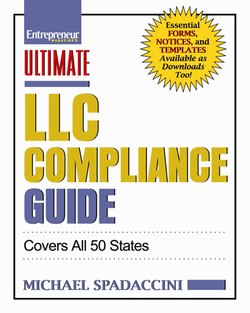Читать книгу Ultimate LLC Compliance Guide - Michael Spadaccini - Страница 27
На сайте Литреса книга снята с продажи.
Classes and Types of Membership
ОглавлениеAll LLCs must have at least one class of ownership with voting rights. Without at least one class of voting ownership shares, an LLC’s owners could not vote and therefore the LLC would be powerless to take any legal action. The overwhelming majority of LLCs, especially small LLCs, have only one class of ownership with voting rights. Typically, you won’t need to overtly claim a voting class of ownership in your articles of organization; the state statute will imply that your LLCs owners enjoy voting rights.
Your LLC may have one or more additional classes of membership interest, if you designate additional classes. Secondary classes of voting interest appear in infinite varieties. But secondary classes are rare and I have never advised their use in my law practice unless it served a very good purpose.
To go forward, we’ll need to borrow some terminology from corporate law. Types of corporate stock can be broadly categorized into three groups: common, preferred, and hybrid. Similarly, an LLC could create multiple classes of ownership. Nevada, for example, allows LLCs to create multiple classes of membership shares.
Common stock is simply plain voting stock, the simplest form of stock. This is equivalent to an LLC’s ordinary membership units.
From here, things get very complicated. Typically, but not always, preferred stock is stock that entitles its holder to a monetary priority or preference over another class of shares. Often, preferred stock entitles the holder to priority in receipt of dividends and, if the corporation liquidates, asset distributions. In other words, preferred stockholders get paid first and common stockholders get what remains. Preferred stock often carries no voting rights. Sometimes preferred stock contains provisions establishing that it can be converted to common stock.
Often, investors who bring capital into the company will insist on getting preferred stock for their investment, so that they get paid first if the company is liquidated. Another common reason for investors insisting on preferred stock is that it entitles them to mandatory dividends.
While a dividend or liquidation preference is the most common feature of preferred stock, preferred stock can have other features. Though it’s far less common, preferred stock can be supervoting. Supervoting preferred stock is a class of stock that entitles the holder to a greater voting percentage per share than a company’s other class or classes of stock. Many states allow the authorization and issuance of supervoting stock and supervoting classes of LLC ownership. Such stock can have 10 votes per share, 100 votes per share, 1,000 votes per share—there is no legal limit on the number of votes per share. Supervoting stock is a powerful device if one wishes to maintain voting control of a corporation or an LLC.
Hybrid stock refers to debt instruments that are convertible into ownership—they are not true equity instruments. For example, a promissory note—a document evidencing a loan—that is convertible into shares of an LLC’s ownership is hybrid stock.
▼ Expert Tip
Don’t issue multiple classes of stock unless you have a clear need. Consider this decision carefully. Multiple classes of stock create a good deal of complexity and increase operating costs; they are more appropriate for larger entities. In my practice, clients often ask me to create and issue multiple classes of shares when it really isn’t necessary. Nearly as often, clients complain later that they should have taken my advice and authorized only one class of stock.
The rights and privileges of all an LLC’s classes of ownership must be set forth in the articles of organization with a certain degree of particularity. Sample clauses establishing multiple classes of shares that you can include in your articles of organization appear in the articles of organization forms in this book.
